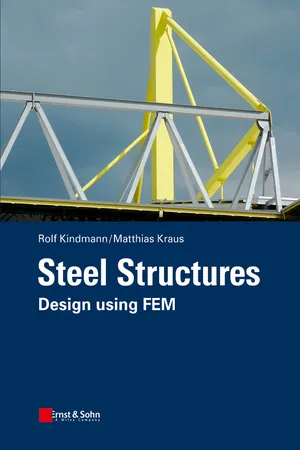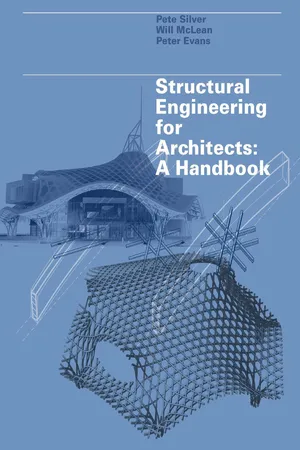Technology & Engineering
Method of Sections
The method of sections is a technique used in structural engineering to analyze the internal forces within a complex structure. By cutting through the structure and isolating a section, engineers can apply equilibrium equations to determine the forces acting on the section. This method is particularly useful for analyzing trusses and other statically determinate structures.
Written by Perlego with AI-assistance
Related key terms
3 Key excerpts on "Method of Sections"
- eBook - ePub
- Paul McMullin, Jonathan Price, Paul W. McMullin, Jonathan S. Price(Authors)
- 2016(Publication Date)
- Routledge(Publisher)
Chapter 10Structural Analysis: Plane Trusses and FramesPaul W. McMullinTrusses and frames are structural systems consisting of many or just a few members. Before computers, engineers solved them manually. Some methods were exact; others approximate (using simplifying assumptions to make them statically determinate). Understanding classical methods of analysis imparts a fundamental understanding of truss and frame behavior and provides a way to validate computer analyses.10.1 Truss AnalysisWe use the Method of Joints, Method of Sections , or Graphical Methods to determine the member forces within trusses, such as those in Figure 10.1 or Figure 10.2 . Two assumptions reduce the number of variables to the available static equilibrium equations. First, members only carry axial load (along their length). Second, joints, where members connect, are pinned but free to rotate. The Method of Joints balances the loads and forces acting at a joint using the equilibrium equations presented in Chapter 5 . The Method of Sections balances the forces acting on a section of a truss using both Equations (5.1) and (6.1) (i.e. the sum of forces and moments on an object must equal zero). Graphical Methods provide another method to balance loads, reactions, and member forces in a geometrical way using Maxwell diagrams . These provide a visual understanding of the individual member forces.10.1.1 Method of Joints
Method of Joints centers on constructing a free body diagram at a joint (Figure 10.3 ) representing the members by a force, then summing forces in the × and y directions. The steps are as follows:-
Step 1: Draw the truss in plan and elevation assuming a depth based on span, available depth, and structural section and material
selection. This process is iterative between geometric constraints and preliminary sizing. There are no right or wrong answers, just options. Some more satisfactory than others.Figure 10.1 Harry S. Truman Bridge, Kansas City, Missouri, 1945
- eBook - ePub
Steel Structures
Design using FEM
- Rolf Kindmann, Matthias Kraus(Authors)
- 2012(Publication Date)
- Ernst & Sohn(Publisher)
The method being described as strain iteration here is also a long-known classic method. It is covered in detail in Section 8.4, but two variants are distinguished here:- Variant 1: The internal forces are directly applied in their full size.
- Variant 2: The internal forces are increased step by step. More information on this can be found in Section 8.4.3 – see Table 8.10 .
application of given internal force as cross section load calculation of strains in the entire cross section determination of the stresses due to the strain distribution (here only σx internal forces) calculation of internal forces from the stresses distribution by integration, and determination of the cross section properties of the elastic rest cross section if the given internal forces are different than the ones of the previous step, repeat the calculation (iteration) Because of the numerical effort involved, this method is only suitable for realisation by computer programs. Here, the cross section is often separated into fibres and stripes (see, for example, Figure 2.18 ). This method is, for example, used by Roik/Kindmann in [71] and Kindmann in [44] for the determination of the cross section bearing capacity due to the σx internal forces and for calculations of frames according to plastic zones theory (see Section 5.12). A detailed description with examples of the method as well as explanations of the determination of shear stresses can be found in Section 8.4. For the following comments the focus is on the principle of this method.The starting point for the determination of the cross section strains is Section 1.6 and Eq. (1.4a) :(8.14)Here, u'S is the strain at the centre of gravity, v''M and w''M the two flexions as well as '' the second derivative of the twist. With the first three terms, a plane area is described complying with the Bernoulli - eBook - ePub
Structural Engineering for Architects
A Handbook
- Pete Silver, Peter Evans, Will McLean(Authors)
- 2014(Publication Date)
- Laurence King Publishing(Publisher)
2Theory2.1General theory of structures2.1.1IntroductionIn structural engineering terms, a building can be considered as a series of individual interconnected components whose function is to transfer externally applied loads through a structural system into the building’s foundations.This chapter examines the types of loads that can be applied to structures and the forces that develop within structural components to resist these externally applied loads.Structural engineering uses the principles of static equilibrium to analyze load distribution. In this chapter the basic concepts of static equilibrium are examined and explained using simple models, while some common mathematical formulae are provided for common beam arrangements.To determine whether a structural component is capable of resisting the loads applied to it, two major factors have to be considered: the component’s size, and the material from which it is made. Further sections of this chapter examine both the geometric and material properties of structural components and their implications on structural performance.While a building’s components must be designed to ensure that they are capable of withstanding the load applied without collapsing, they must also be designed to ensure they can perform their desired purpose without wobbling, deflecting, or vibrating to such an extent as to disturb the building’s occupants or cause damage to fittings and fixtures. These criteria are often called “in service” or “serviceability” states and are explained in the section in this chapter entitled “Fitness for purpose.”
Index pages curate the most relevant extracts from our library of academic textbooks. They’ve been created using an in-house natural language model (NLM), each adding context and meaning to key research topics.


